Power Optimization of Partially Shaded PV System Using Interleaved Boost Converter-Based Fuzzy Logic Method
Abstract
1. Introduction
2. Materials and Methods
2.1. Modeling of Class and Interleaved Boost Converter
2.2. Analyzed PV Systems with CBC and IBC
2.2.1. PV Energy System Integrated CBC
2.2.2. PV Energy System Integrating IBC
2.3. Fuzzy Controller Design
2.3.1. Fuzzy Control
2.3.2. Structure of Fuzzy Logic
- (a)
- Two inputs: Error (E) and change in error (DE); range: [−1, 1]; Gaussian membership functions.
- (b)
- Control fuzzy logic: A total of 25 fuzzy rules are applied using Mamdani inference, as shown Table 2. Each rule connects two inputs and one output, as shown in the table, using the Inference Engine method (AND Method (min), OR Method (max)) and then converting the results into an actual control output signal using the centroid method. This method computes the centroid of the fuzzy form.
- (c)
- One output (dD): Range: [−1, 1]; the correction signal controls for changes in duty cycle (dD) using centroid-based defuzzification over Gaussian double-output membership functions.
2.3.3. Summary of Flow Chat Implementation Steps for Fuzzy Logic Controller
- Step 1.
- Input Variables (E, dE):The error (E) and change in error (dE) as inputs to the fuzzy logic controller.
- Step 2.
- Fuzzification:The crisp input values (E and dE) are converted into fuzzy values using membership functions (MFs). Here, you use Gaussian MFs to represent the fuzziness of the input data.
- Step 3.
- Rule Evaluation:The fuzzy rules (“If E is NB and dE is NB, then dD is NB”) are applied to evaluate the fuzzy outputs. You have 25 rules to determine the fuzzy control action.
- Step 4.
- Aggregation:The outputs of all the active rules are combined to create an aggregated fuzzy output. This step combines the contributions of each rule based on the fuzzified inputs.
- Step 5.
- Defuzzification:The centroid technique is used to transform the fuzzy output back into a crisp value. This method calculates the weighted average of the fuzzy set to produce a crisp output.
- Step 6.
- Control Signal (dD):The crisp output (dD) is used to adjust the system. This is the control action that your FLC generates. Fuzzy logic offers faster response, adapts to nonlinearity, is noise-resistant, and reduces oscillation at MPP through comparisons with incremental conductance and perturb and observe methods. Table 3 shows the advantages and disadvantages of these three different methods of MPPT.
| Method of MPPT | Advantages | Disadvantages |
|---|---|---|
| Fuzzy controller |
|
|
| Incremental Conductance |
|
|
| Perturb and Observe |
|
|
2.4. Control Strategy of Voltage Source Converter
3. Results
3.1. Performance of Interleaved Boost Converter (IBC)-Based Fuzzy Logic MPPT
3.1.1. Performance of IBC for Constant-Level Irradiance (CLI)
3.1.2. Performance of IBC Under Partial Shading Conditions (PSCs)
3.2. Performance Class Boost Converter (CBC)-Based Fuzzy Logic MPPT
3.2.1. Performance of CBC with Constant Irradiance Level (CLI)
3.2.2. Performance of CBC Under Partial Shading Conditions
4. Discussion
5. Comparative Analysis with Comparable Studies
6. Conclusions
Author Contributions
Funding
Institutional Review Board Statement
Informed Consent Statement
Data Availability Statement
Conflicts of Interest
Abbreviations
| PV | Photovoltaic |
| MPPT | Maximum power point tracker |
| CBC | Class boost converter |
| IBC | Interleaved boost converter |
| CLI | Constant level irradiance (constant weather conditions) |
| PSCs | Partial shading conditions |
| THD | Total harmonic distortion |
References
- Rajendran, G.; Raute, R.; Caruana, C. A Comprehensive Review of Solar PV Integration with Smart-Grids: Challenges, Standards, and Grid Codes. Energies 2025, 18, 2221. [Google Scholar] [CrossRef]
- Endiz, M.S.; Gökkuş, G.; Coşgun, A.E.; Demir, H. A Review of Traditional and Advanced MPPT Approaches for PV Systems Under Uniformly Insolation and Partially Shaded Conditions. Appl. Sci. 2025, 15, 1031. [Google Scholar] [CrossRef]
- Eltamaly, A.M. An improved cuckoo search algorithm for maximum power point tracking of photovoltaic systems under partial shading conditions. Energies 2021, 14, 953. [Google Scholar] [CrossRef]
- Al-Samawi, A.A.; Alkhafaji, A.S.; Atiyah, A.S.; Trabelsi, H. Review Mitigation Methods of Partial Shading Condition for PV System. In Proceedings of the 2024 21st International Multi-Conference on Systems, Signals & Devices (SSD), Erbil, Iraq, 22–25 April 2024; pp. 401–410. [Google Scholar] [CrossRef]
- Al-Samawi, A.A.; Trabelsi, H. New Nine-Level Cascade Multilevel Inverter with a Minimum Number of Switches for PV Systems. Energies 2022, 15, 5857. [Google Scholar] [CrossRef]
- Farh, H.M.H.; Othman, M.F.; Eltamaly, A.M.; Al-Saud, M.S. Maximum power extraction from a partially shaded PV system using an interleaved boost converter. Energies 2018, 11, 2543. [Google Scholar] [CrossRef]
- Maghami, M.R.; Hizam, H.; Gomes, C.; Radzi, M.A.; Rezadad, M.I.; Hajighorbani, S. Power loss due to soiling on solar panel: A review. Renew. Sustain. Energy Rev. 2016, 59, 1307–1316. [Google Scholar] [CrossRef]
- Al-Samawi, A.A.; Trabelsi, H. Power Quality Enhancement of PV System Based on Modified Three-Phase Cascaded Multilevel Inverter. In Proceedings of the 2022 19th International Multi-Conference on Systems, Signals & Devices (SSD), Setif, Algeria, 6–10 May 2022; pp. 339–346. [Google Scholar] [CrossRef]
- Alves, T.; N. Torres, J.P.; Marques Lameirinhas, R.A.; F. Fernandes, C.A. Different techniques to mitigate partial shading in photovoltaic panels. Energies 2021, 14, 3863. [Google Scholar] [CrossRef]
- Duong, M.Q.; Sava, G.N.; Ionescu, G.; Necula, H.; Leva, S.; Mussetta, M. Optimal bypass diode configuration for PV arrays under shading influence. In Proceedings of the 2017 IEEE International Conference on Environment and Electrical Engineering and 2017 IEEE Industrial and Commercial Power Systems Europe (EEEIC/I&CPS Europe), Milan, Italy, 6–9 June 2017; pp. 1–5. [Google Scholar] [CrossRef]
- Al-Samawi, A.A.; Trabelsi, H. Seven-level Cascade Multilevel Inverter based Minimum Switches for Photovoltaic applications. In Proceedings of the 2023 20th International Multi-Conference on Systems, Signals & Devices (SSD), Mahdia, Tunisia, 20–23 February 2023; pp. 957–966. [Google Scholar] [CrossRef]
- Ishaque, K.; Salam, Z.; Lauss, G. The performance of perturb and observe and incremental conductance maximum power point tracking method under dynamic weather conditions. Appl. Energy 2014, 119, 228–236. [Google Scholar] [CrossRef]
- Ahmed, J.; Salam, Z. An improved perturb and observe (P&O) maximum power point tracking (MPPT) algorithm for higher efficiency. Appl. Energy 2015, 150, 97–108. [Google Scholar] [CrossRef]
- Xia, K.; Li, Y.; Zhu, B. Improved photovoltaic MPPT algorithm based on ant colony optimization and fuzzy logic under conditions of partial shading. IEEE Access 2024, 12, 44817–44825. [Google Scholar] [CrossRef]
- Titri, S.; Larbes, C.; Toumi, K.Y.; Benatchba, K. A new MPPT controller based on the Ant colony optimization algorithm for Photovoltaic systems under partial shading conditions. Appl. Soft Comput. 2017, 58, 465–479. [Google Scholar] [CrossRef]
- Ishaque, K.; Salam, Z.; Amjad, M.; Mekhilef, S. An improved particle swarm optimization (PSO)–based MPPT for PV with reduced steady-state oscillation. IEEE Trans. Power Electron. 2012, 27, 3627–3638. [Google Scholar] [CrossRef]
- Saady, I.; Majout, B.; Bossoufi, B.; Karim, M.; Elkafazi, I.; Merzouk, S.; Almalki, M.M.; Alghamdi, T.A.H.; Skruch, P.; Zhilenkov, A. Improving photovoltaic water pumping system performance with PSO-based MPPT and PSO-based direct torque control using real-time simulation. Sci. Rep. 2025, 15, 16127. [Google Scholar] [CrossRef] [PubMed]
- Miyatake, M.; Toriumi, F.; Endo, T.; Fujii, N. A novel maximum power point tracker controlling several converters connected to photovoltaic arrays with particle swarm optimization technique. In Proceedings of the 2007 European Conference on Power Electronics and Applications, Aalborg, Denmark, 2–5 September 2007; pp. 1–10. [Google Scholar] [CrossRef]
- Danyali, S.; Babaeifard, M.; Shirkhani, M.; Azizi, A.; Tavoosi, J.; Dadvand, Z. A new neuro-fuzzy controller based maximum power point tracking for a partially shaded grid-connected photovoltaic system. Heliyon 2024, 10, e36747. [Google Scholar] [CrossRef] [PubMed]
- Ramaprabha, R.; Balaji, K.; Raj, S.; Logeshwaran, V. Comparison of interleaved boost converter configurations for solar photovoltaic system interface. J. Eng. Res. 2013, 10, 87–98. [Google Scholar] [CrossRef]
- Rehman, Z.; Al-Bahadly, I.; Mukhopadhyay, S. Multiinput DC–DC converters in renewable energy applications. An overview. Renew. Sustain. Energy Rev. 2015, 41, 521–539. [Google Scholar] [CrossRef]
- Khosroshahi, A.; Abapour, M.; Sabahi, M. Reliability evaluation of conventional and interleaved DC–DC boost converters. IEEE Trans. Power Electron. 2015, 30, 5821–5828. [Google Scholar] [CrossRef]
- Prasanth, P.; Seyezhai, R. Investigation of four phase interleaved boost converter under open loop andclosed loop control schemes for battery charging applications. Int. J. Adv. Materi. Sci. Eng. 2016, 5, 2201–2311. [Google Scholar] [CrossRef]
- Aghdam, F.H.; Hagh, M.T.; Abapour, M. Reliability evaluation of two-stage interleaved boost converter interfacing PV panels based on mode of use. In Proceedings of the 2016 7th Power Electronics and DriveSystems Technologies Conference (PEDSTC), Tehran, Iran, 16–18 February 2016; pp. 409–414. [Google Scholar] [CrossRef]
- Lai, C.-M.; Cheng, Y.-H.; Teh, J.; Lin, Y.-C. A New Combined Boost Converter with Improved Voltage Gain as a Battery-Powered Front-End Interface for Automotive Audio Amplifiers. Energies 2017, 10, 1128. [Google Scholar] [CrossRef]
- Farh, H.M.H.; Eltamaly, A.M.; Al-Saud, M.S. Interleaved Boost Converter for Global Maximum Power Extraction from the Photovoltaic System under Partial Shading. IET Renew. Power Gener. 2019, 13, 1232–1238. [Google Scholar] [CrossRef]
- Semiromizadeh, J.; Izadi, H.; Adib, E. High step-up interleaved DC-DC converter for photovoltaic systems. IET Power Electron. 2022, 15, 33–42. [Google Scholar] [CrossRef]
- Chen, S.-J.; Yang, S.-P.; Huang, C.-M.; Hu, P.-Y. High Step-Up Interleaved DC–DC Converter with Voltage-Lift Capacitor and Voltage Multiplier Cell. Electronics 2025, 14, 1209. [Google Scholar] [CrossRef]
- Robin, C.S.; Raji, J.; Yaseen, M.D.; Jothippriya, N.; Irfan, M.M.; Shivasankkar, I. Interleaved Boost Converter with Optimized MPPT Approach for Renewable Energy Based Propulsion System of EV. In Proceedings of the 2025 3rd International Conference on Device Intelligence, Computing and Communication Technologies (DICCT), Dehradun, India, 21–22 March 2025; pp. 367–372. [Google Scholar] [CrossRef]
- Erickson, R.W.; Maksimovic, D. Fundamentals of Power Electronics; Springer Science & Business Media: Berlin, Germany, 2007; ISBN 0306480484. [Google Scholar] [CrossRef]
- Kolluru, V.R.; Patjoshi, R.K.; Panigrahi, R. A Comprehensive Review on Maximum Power Tracking of a Photovoltaic System under Partial Shading Conditions. Int. J. Renew. Energy Res. 2019, 9, 175–186. [Google Scholar] [CrossRef]
- Robles Algarín, C.; Taborda Giraldo, J.; Rodriguez Alvarez, O. Fuzzy logic based MPPT controller for a PV system. Energies 2017, 10, 2036. [Google Scholar] [CrossRef]
- Kovacic, Z.; Bogdan, S. Fuzzy Controller Design: Theory and Applications; CRC Press: Boca Raton, FL, USA, 2018; ISBN 1315221144. [Google Scholar] [CrossRef]
- Rezk, H.; Aly, M.; Al-Dhaifallah, M.; Shoyama, M. Design and hardware implementation of new adaptive fuzzy logic-based MPPT control method for photovoltaic applications. IEEE Access 2019, 7, 106427–106438. [Google Scholar] [CrossRef]
- Ahmed, O.K.; Daoud, R.W.; Bawa, S.M.; Ahmed, A.H. Optimization of PV/T Solar Water Collector based on Fuzzy Logic Control. Int. J. Renew. Energy Dev. 2020, 9, 303–310. [Google Scholar] [CrossRef]
- Belrzaeg, M.; Abou Sif, M. Fuzzy logic controller-based enhancement for grid-connected large-scale PV systems. Magna Sci. Adv. Res. Rev. 2023, 9, 009–023. [Google Scholar] [CrossRef]
- Eltamaly, A.M.; Alotaibi, M.A. Novel Hybrid Mexican Axolotl Optimization with Fuzzy Logic for Maximum Power Point Tracker of Partially Shaded Photovoltaic Systems. Energies 2024, 17, 2445. [Google Scholar] [CrossRef]
- Fkirin, M.A.; Gowaly, Z.M.; Elsheikh, E.A. Dynamic Controller Design for Maximum Power Point Tracking Control for Solar Energy Systems. Technologies 2025, 13, 71. [Google Scholar] [CrossRef]
- Nzoundja Fapi, C.B.; Tchakounté, H.; Ndje, M.; Wira, P.; Abdeslam, D.O.; Louzazni, M.; Kamta, M. Fuzzy Logic-Based Maximum Power Point Tracking Control for Photovoltaic Systems: A Review and Experimental Applications. Arch. Comput. Methods Eng. 2025, 1–24. [Google Scholar] [CrossRef]
- López-Eugenio, K.; Torres-Bermeo, P.; Del-Valle-Soto, C.; Varela-Aldás, J. Projection of Photovoltaic System Adoption and Its Impact on a Distributed Power Grid Using Fuzzy Logic. Sustainability 2025, 17, 5235. [Google Scholar] [CrossRef]
- Kumar, S.S.; Balakrishna, K. A novel design and analysis of hybrid fuzzy logic MPPT controller for solar PV system under partial shading conditions. Sci. Rep. 2024, 14, 10256. [Google Scholar] [CrossRef]
- Pushpavalli, M.; Jothi Swaroopan, N.M. Maximum power tracking for PV array system using fuzzy logic controller. In International Conference on Intelligent Computing and Applications: Proceedings of ICICA 2018; Springer: Singapore, 2019; pp. 337–348. [Google Scholar] [CrossRef]
- Selman, N.H.; Mahmood, J.R. Comparison between perturb & observe, incremental conductance and fuzzy logic MPPT techniques at different weather conditions. Int. J. Innov. Res. Sci. Eng. Technol. 2016, 5, 12556–12569. [Google Scholar] [CrossRef]
- Rajput, S.; Averbukh, M.; Yahalom, A.; Minav, T. An approval of MPPT based on PV Cell’s simplified equivalent circuit during fast-shading conditions. Electronics 2019, 8, 1060. [Google Scholar] [CrossRef]
- Ali, A.; Almutairi, K.; Malik, M.Z.; Irshad, K.; Tirth, V.; Algarni, S.; Zahir, M.H.; Islam, S.; Shafiullah, M.; Shukla, N.K. Review of online and soft computing maximum power point tracking techniques under non-uniform solar irradiation conditions. Energies 2020, 13, 3256. [Google Scholar] [CrossRef]
- Srivastava, A.; Nagvanshi, A.; Chandra, A.; Singh, A.; Roy, A.K. Grid integrated solar PV system with comparison between fuzzy logic controlled MPPT and P&O MPPT. In Proceedings of the 2021 IEEE 2nd international conference on electrical power and energy systems (ICEPES), Bhopal, India, 10–11 December 2021; pp. 1–6. [Google Scholar] [CrossRef]
- Seba, S.; Mouhoub, B.; Benmouiza, K. A Comparative Analysis of series and parallel topologies of Perturb and Observe (P&O) and Incremental Conductance (InC) MPPT Algorithms for Photovoltaic System. Alger. J. Renew. Energy Sustain. Dev. 2023, 5, 11–21. [Google Scholar] [CrossRef]
- Zhani, N.; Mahmoudi, H. Comparison of the performance of MPPT control techniques (Fuzzy Logic, Incremental Conductance and Perturb & Observe) under MATLAB/Simulink. IFAC-PapersOnLine 2024, 58, 617–623. [Google Scholar] [CrossRef]
- Ramanathan, G.G.; Urasaki, N. Non-isolated interleaved hybrid boost converter for renewable energy applications. Energies 2022, 15, 610. [Google Scholar] [CrossRef]
- Kabalci, E.; Boyar, A. Highly efficient interleaved solar converter controlled with extended kalman filter MPPT. Energies 2022, 15, 7838. [Google Scholar] [CrossRef]
- Wu, S.-T.; Hong, J.-T.; Chuang, C.-C. Design of an Interleaved Boost Serial Resonant Converter with High Transformation Ratio for Fuel Cell Battery. IEEE Access 2025, 13, 19219–19236. [Google Scholar] [CrossRef]
- Krishnaram, K.; Padmanabhan, T.S.; Alsaif, F.; Senthilkumar, S. Performance optimization of interleaved boost converter with ANN supported adaptable stepped-scaled P&O based MPPT for solar powered applications. Sci. Rep. 2024, 14, 8115. [Google Scholar] [CrossRef]
- Uzmus, H.; Genc, N.; Celık, M.A. The modified MPPT for PV system with interleaved hybrid DC-to-DC boost converter. Electr. Power Compon. Syst. 2023, 51, 46–58. [Google Scholar] [CrossRef]
- Mumtaz, F.; Yahaya, N.Z.; Meraj, S.T.; Singh, N.S.S.; Rahman, M.S.; Hossain Lipu, M.S. A high voltage gain interleaved DC-DC converter integrated fuel cell for power quality enhancement of microgrid. Sustainability 2023, 15, 7157. [Google Scholar] [CrossRef]
- Garraoui, R.; Omri, B.; Ben Hamed, M.; Sbita, L. A Novel ANN-DISM MPPT Controller for Solar Applications Under Partial Shading with Two-Phase Interleaved Boost Converter. Arab. J. Sci. Eng. 2025, 1–15. [Google Scholar] [CrossRef]
- Mishra, A.; Mandal, S.; Dieulot, J.-Y.; Bachute, M.; Faizan, M.; Pinnarelli, A.; Heidari, M.; Soleimani, A. Non-Linear Control of Interleaved Boost Converter Using Disturbance Observer Based Approach. IEEE Access 2025, 13, 23833–23840. [Google Scholar] [CrossRef]
- Setiyawan, F.I.; Pratomo, L.H. Design and Implementation of Two-phase Boost Inverter using Interleaved Method to Increase Output Current. Kinet. Game Technol. Inf. Syst. Comput. Netw. Comput. Electron. Control 2025, 10. [Google Scholar] [CrossRef]

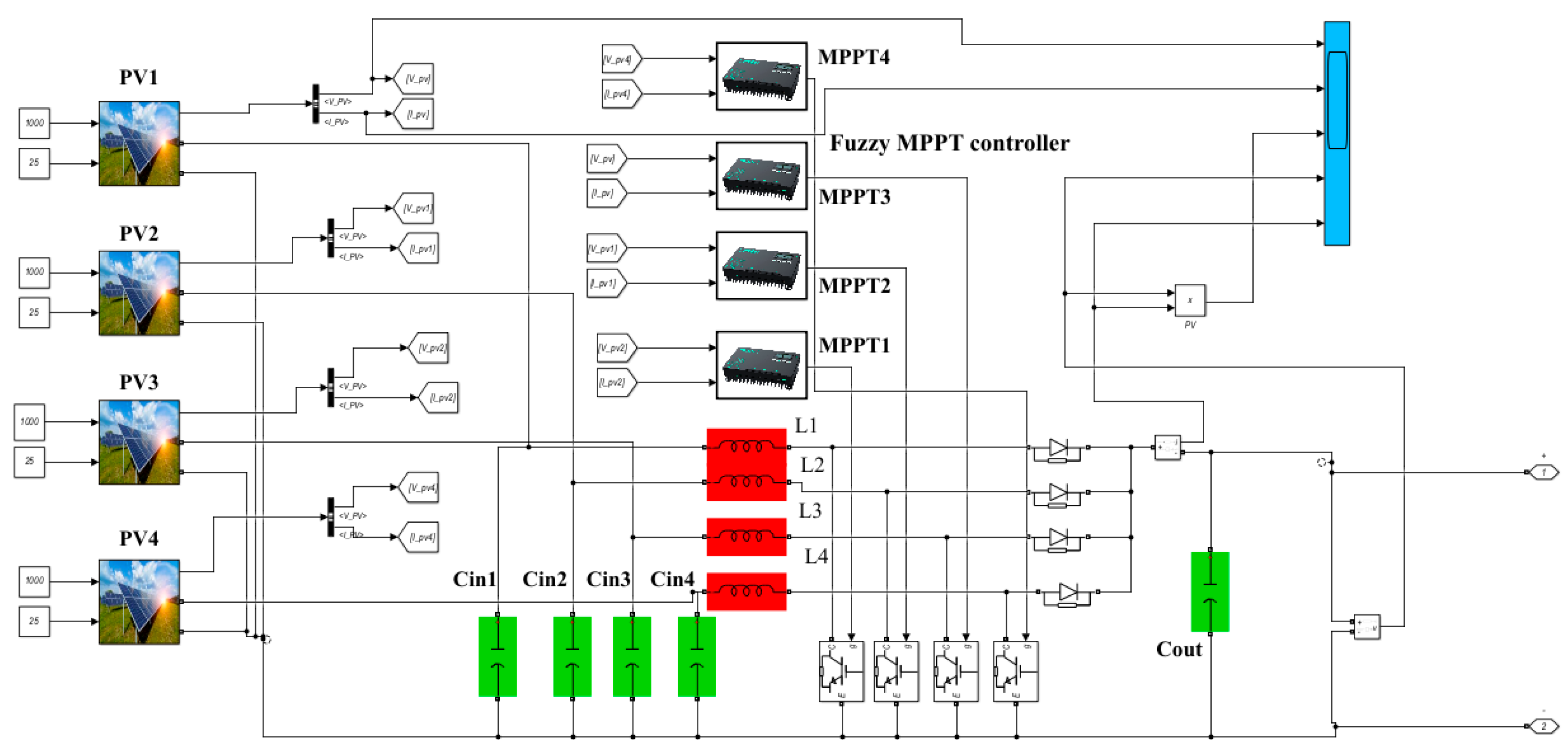
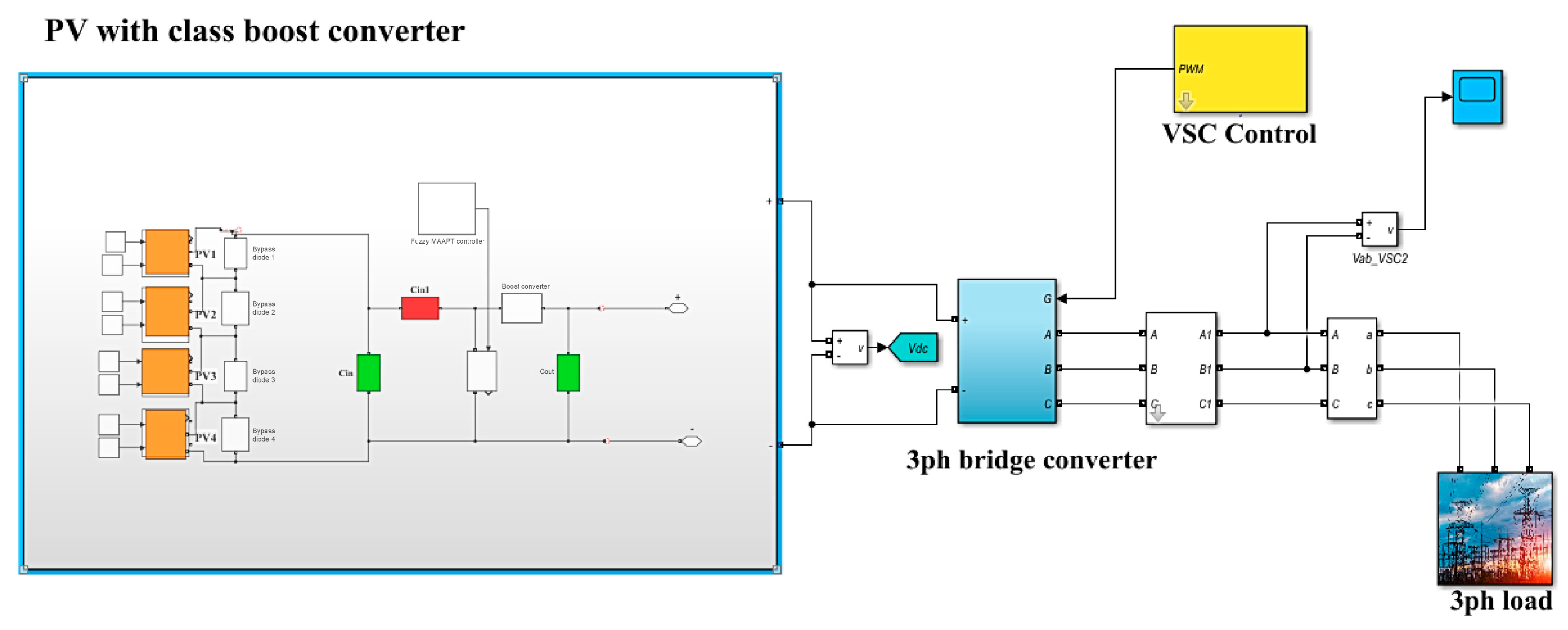
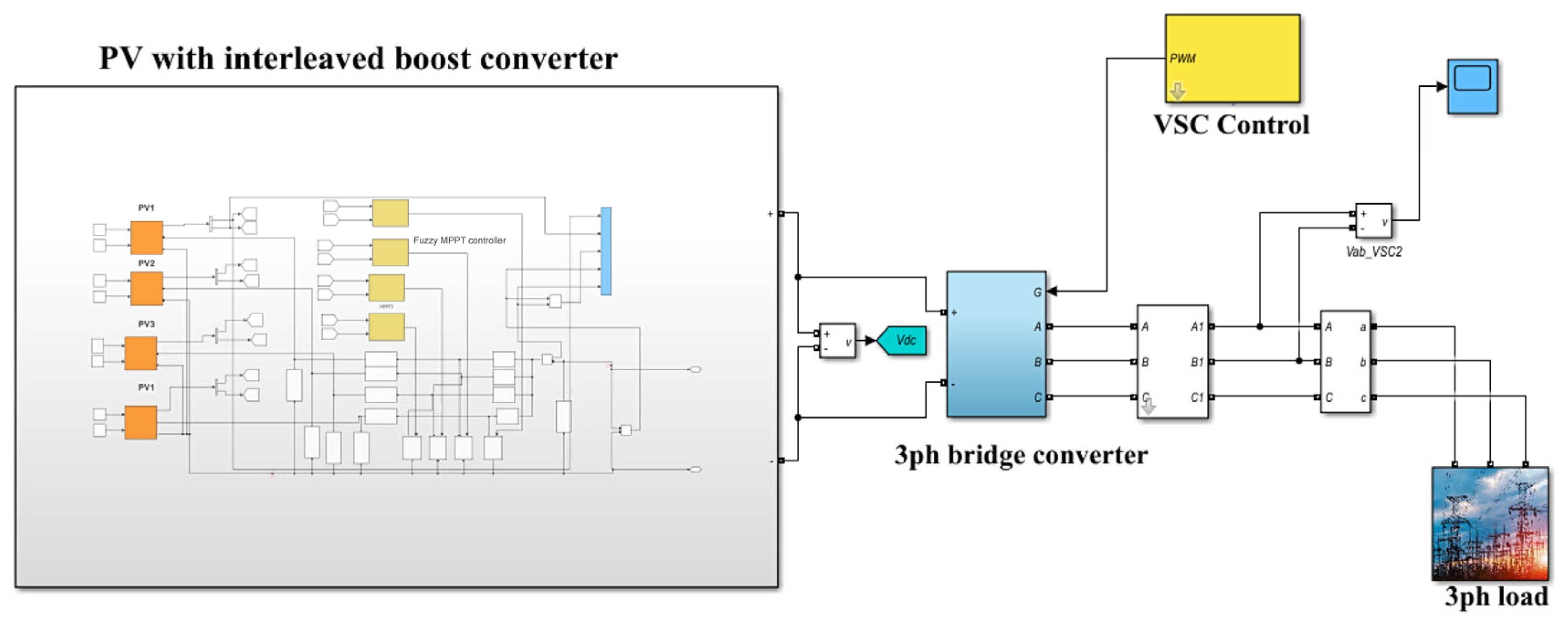
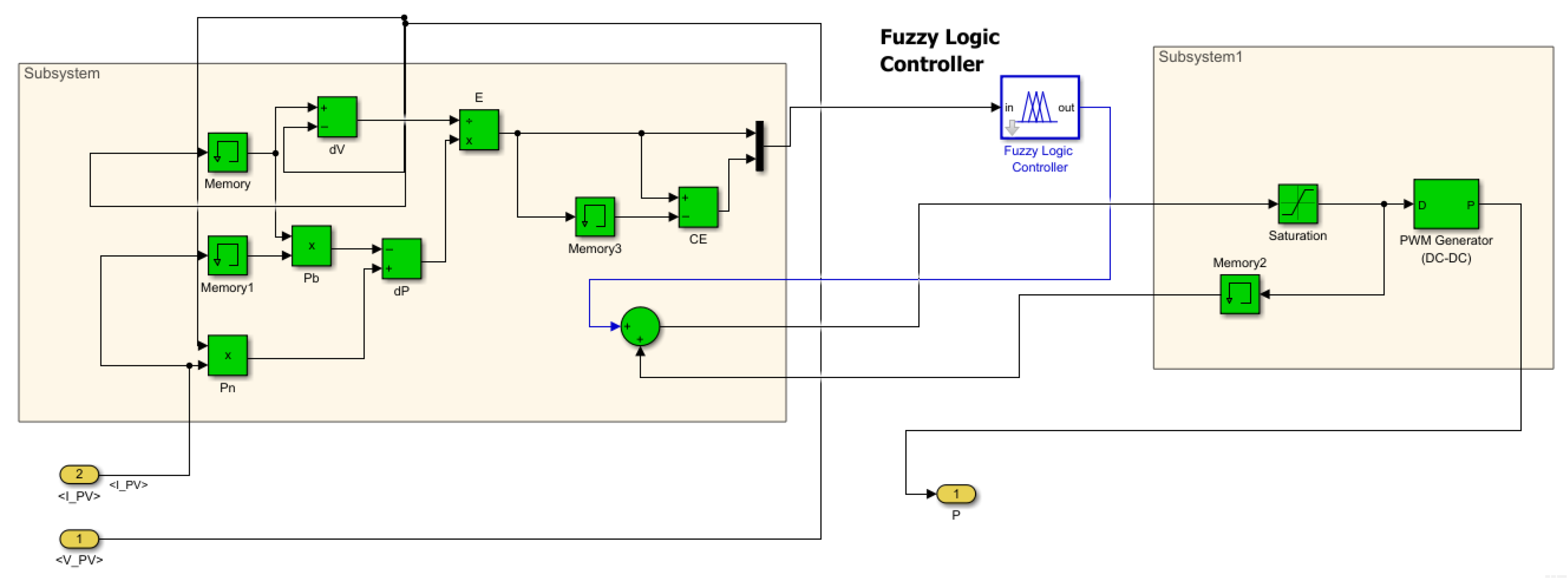
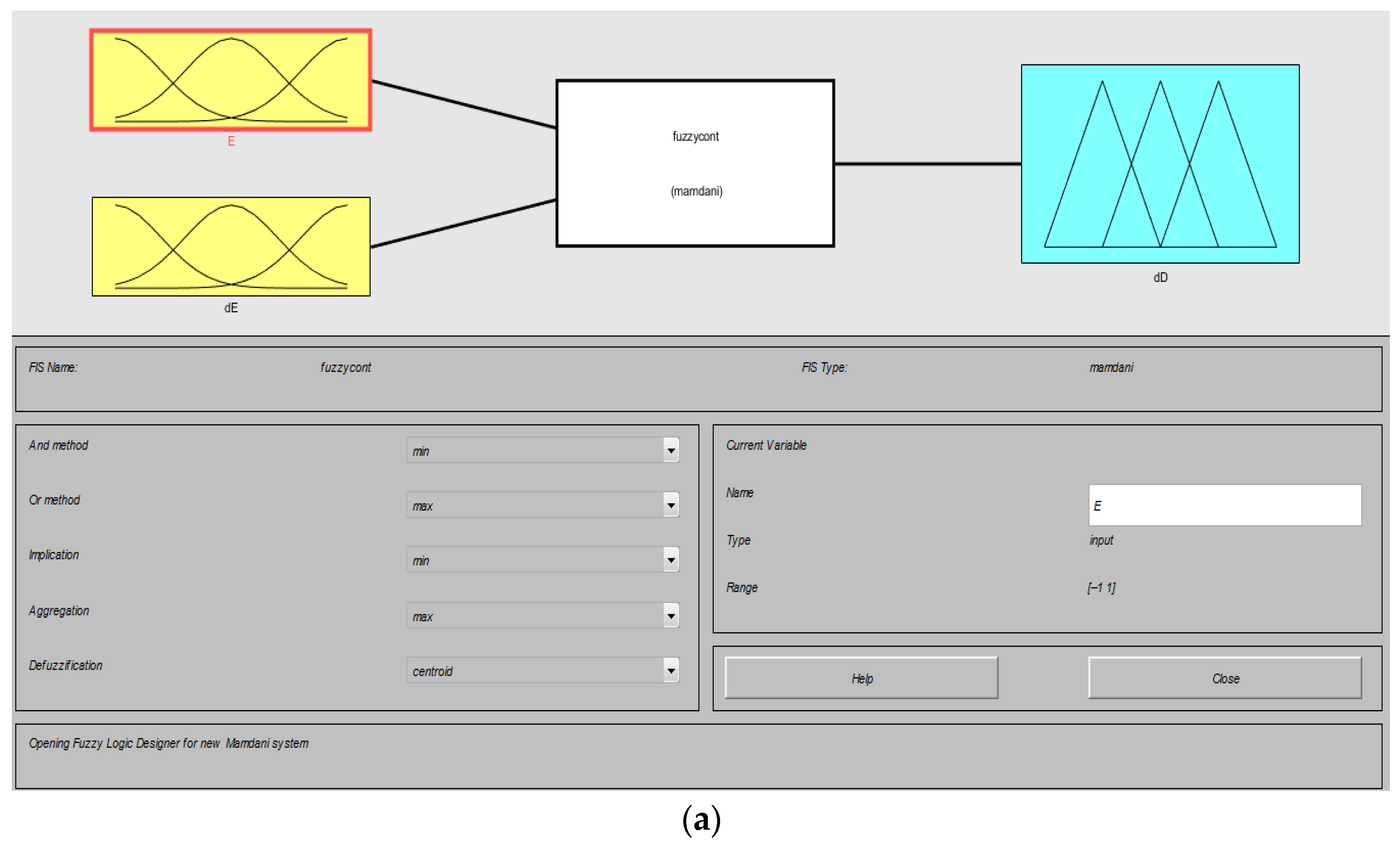
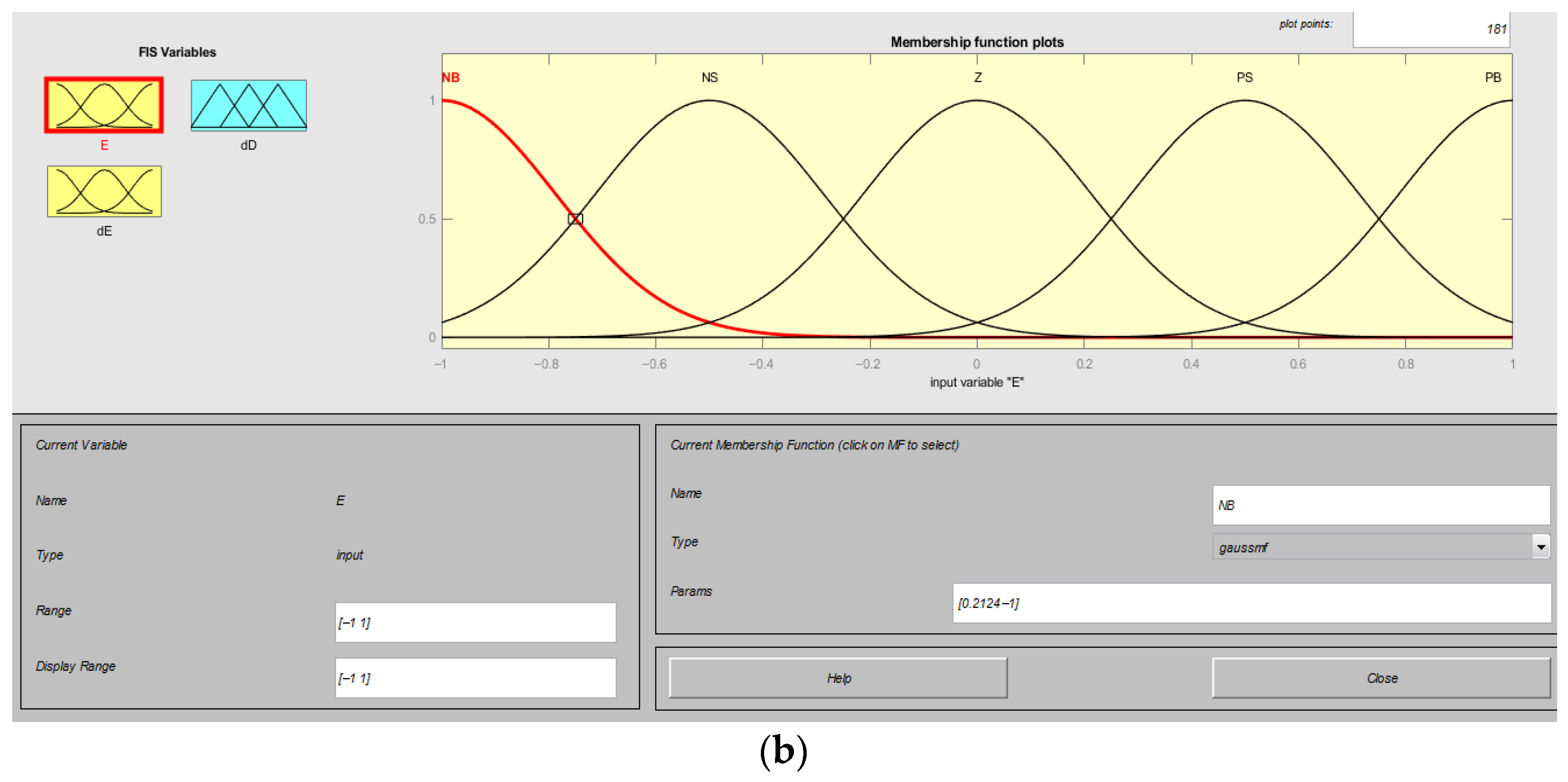
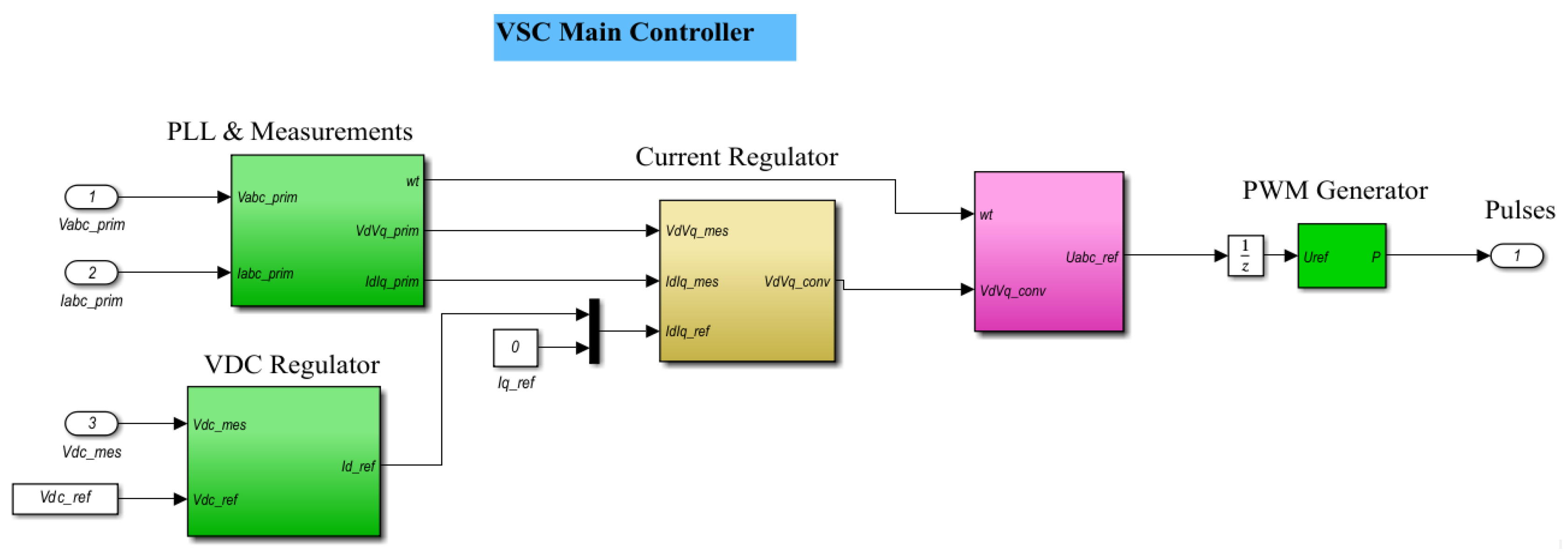
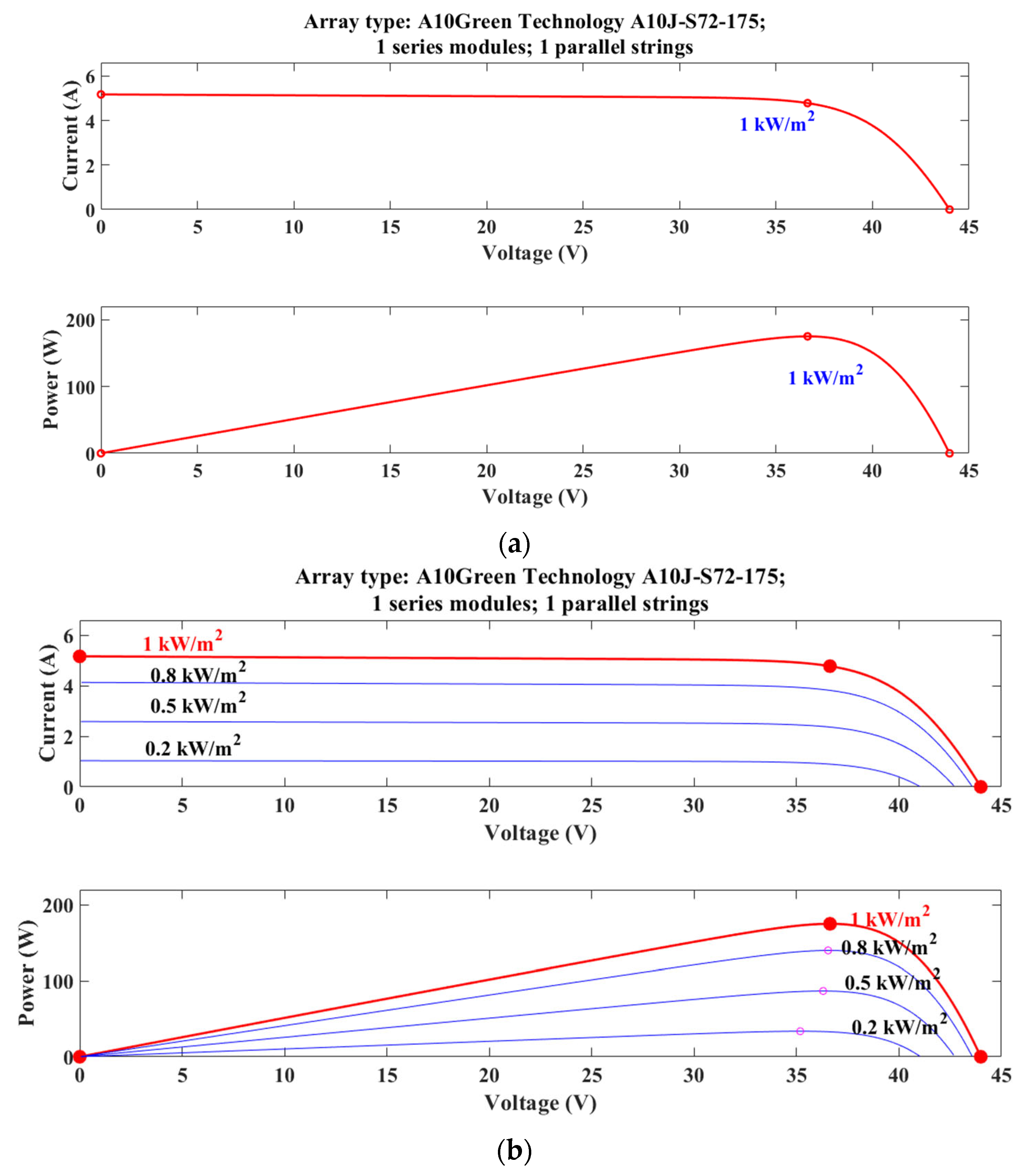

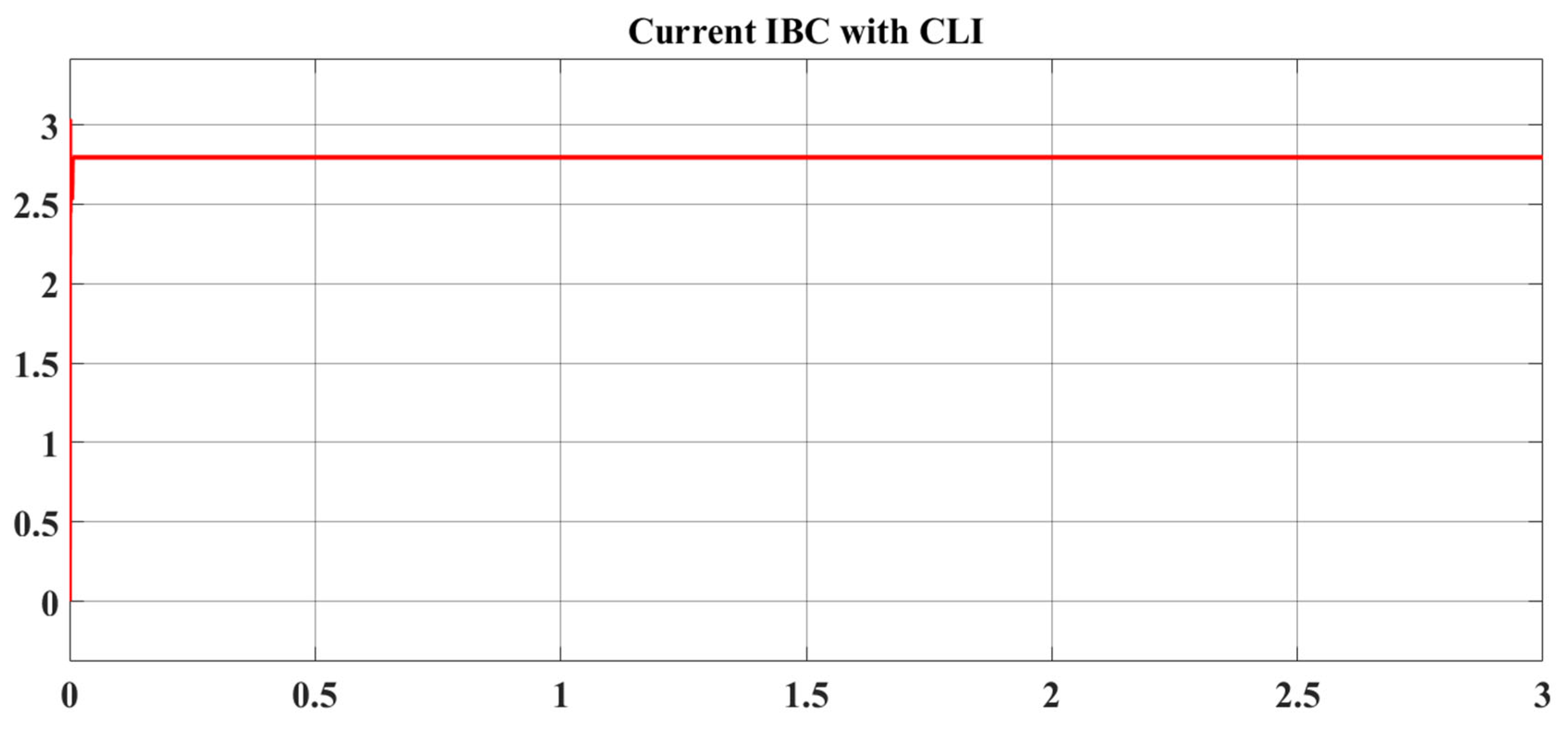

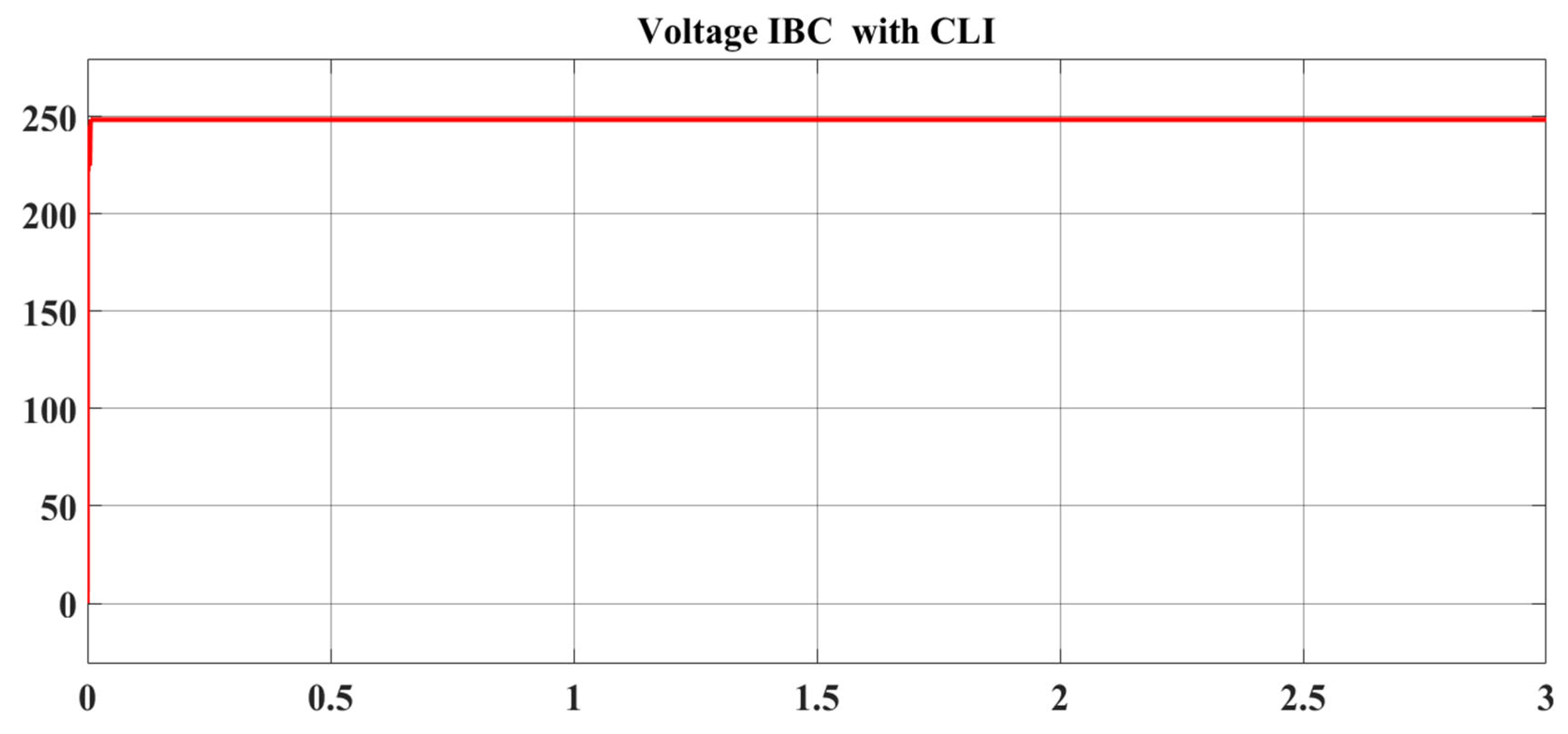
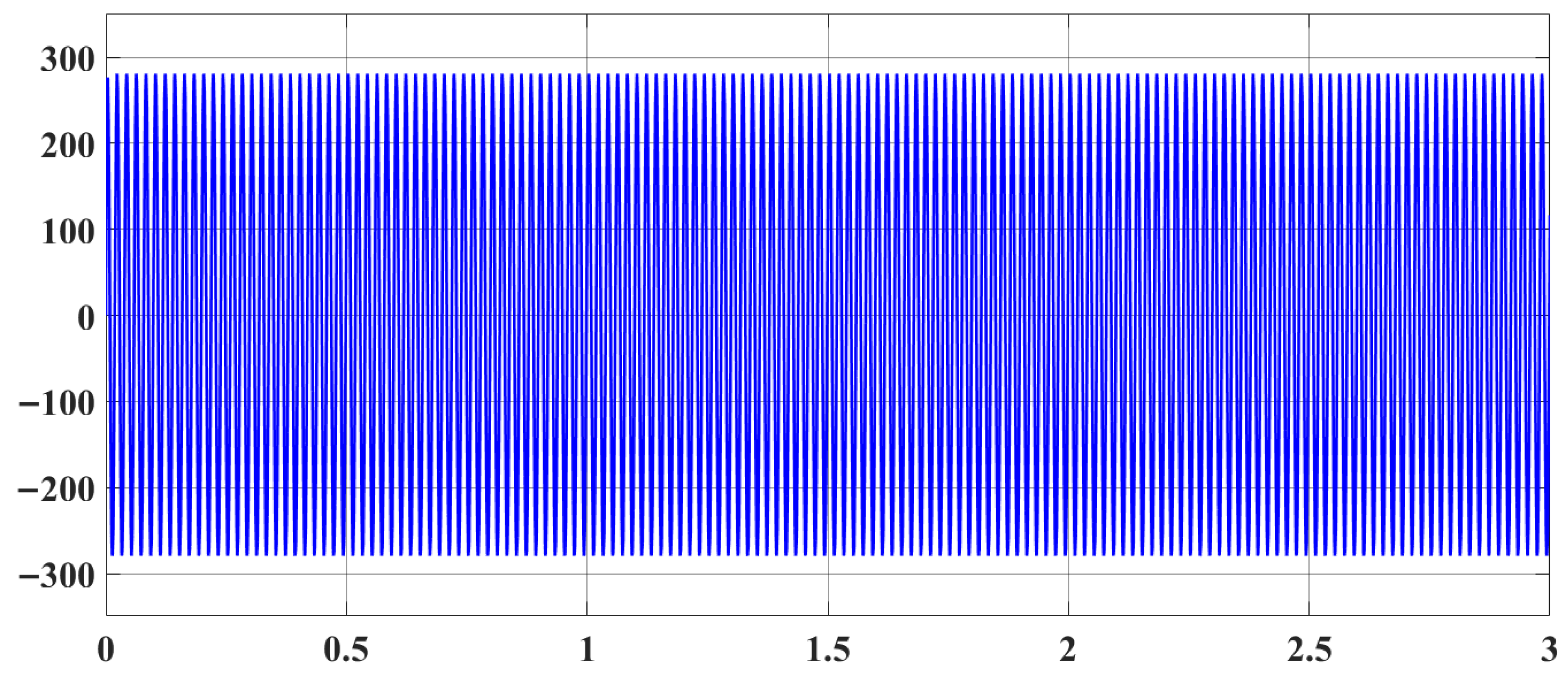
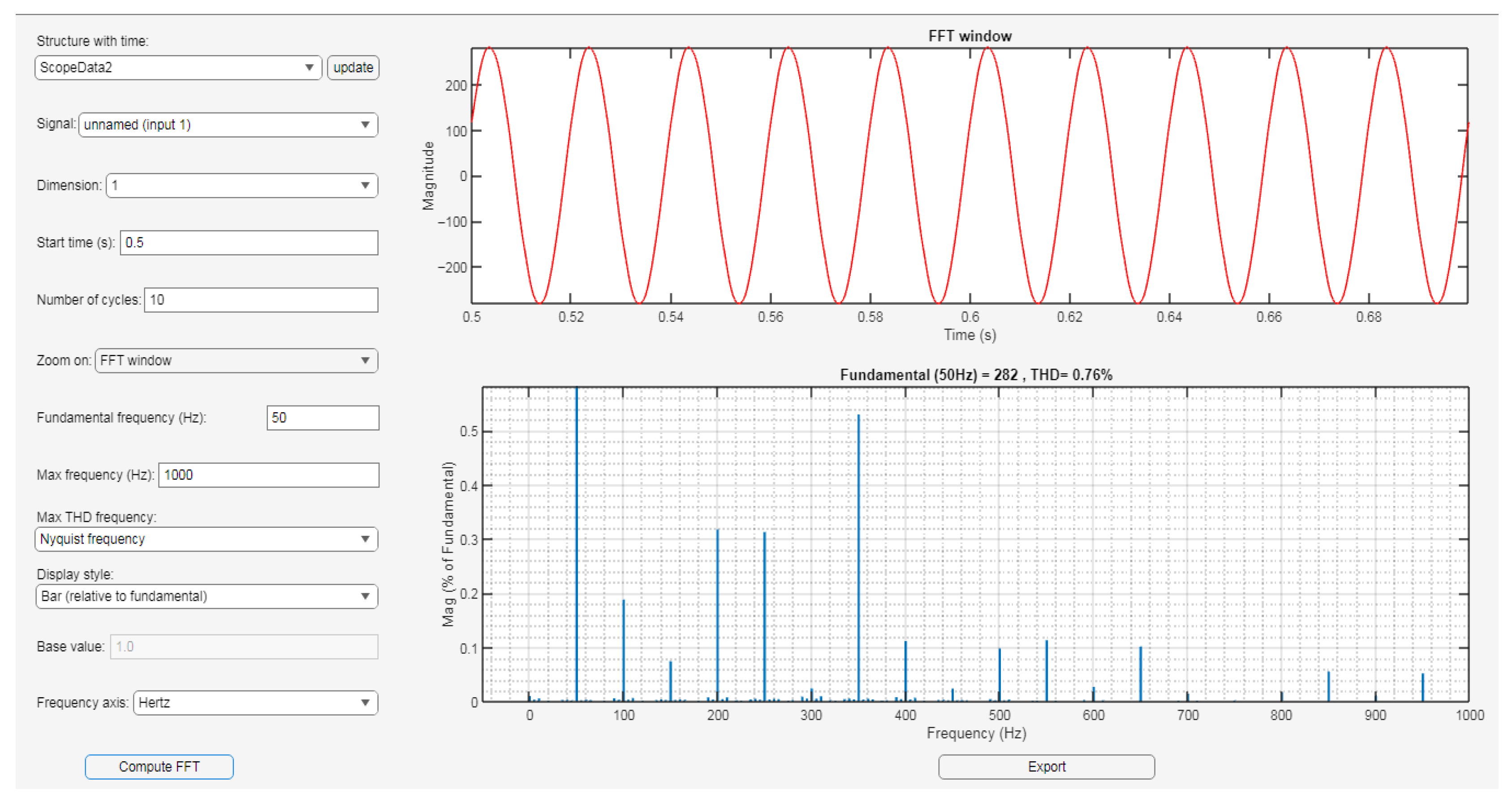


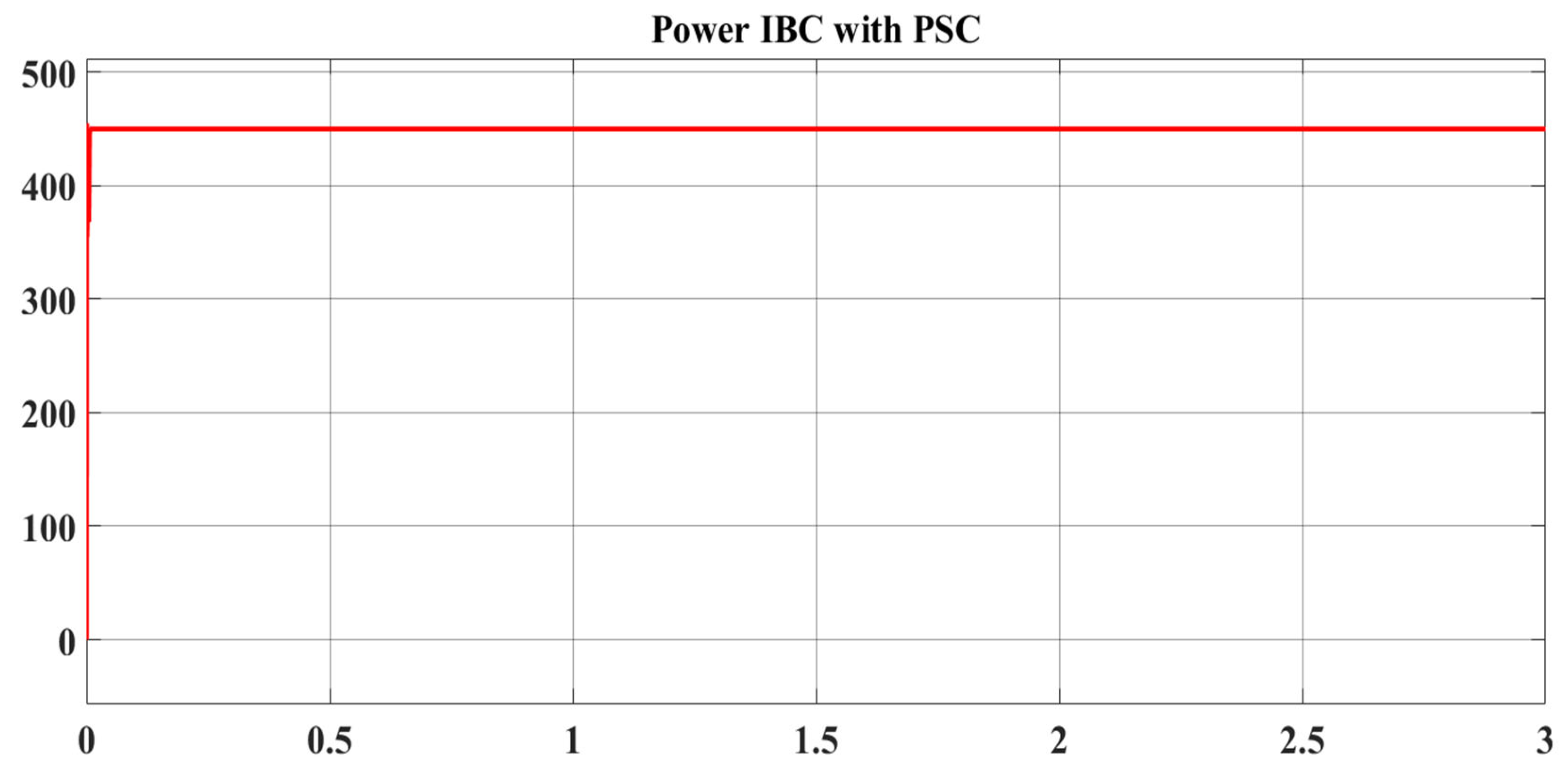


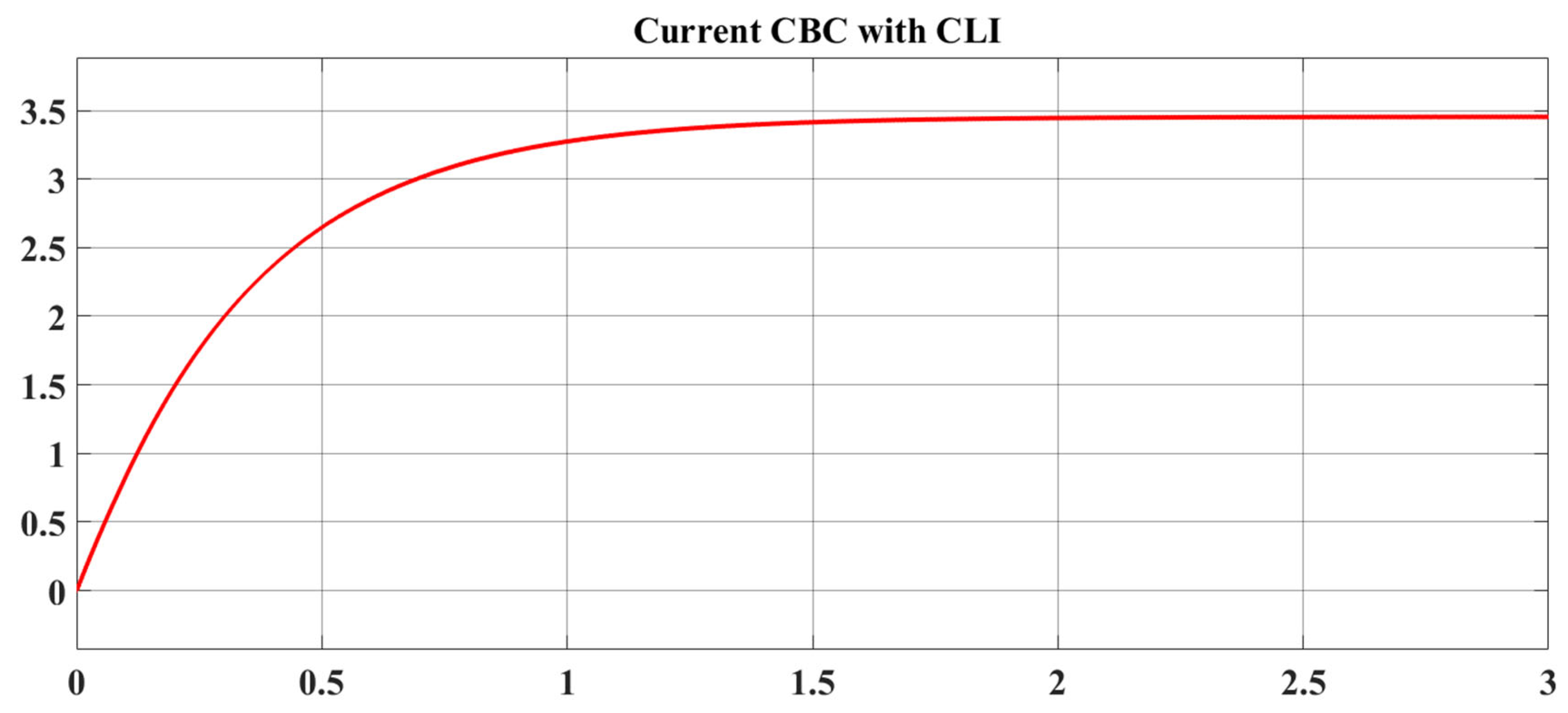
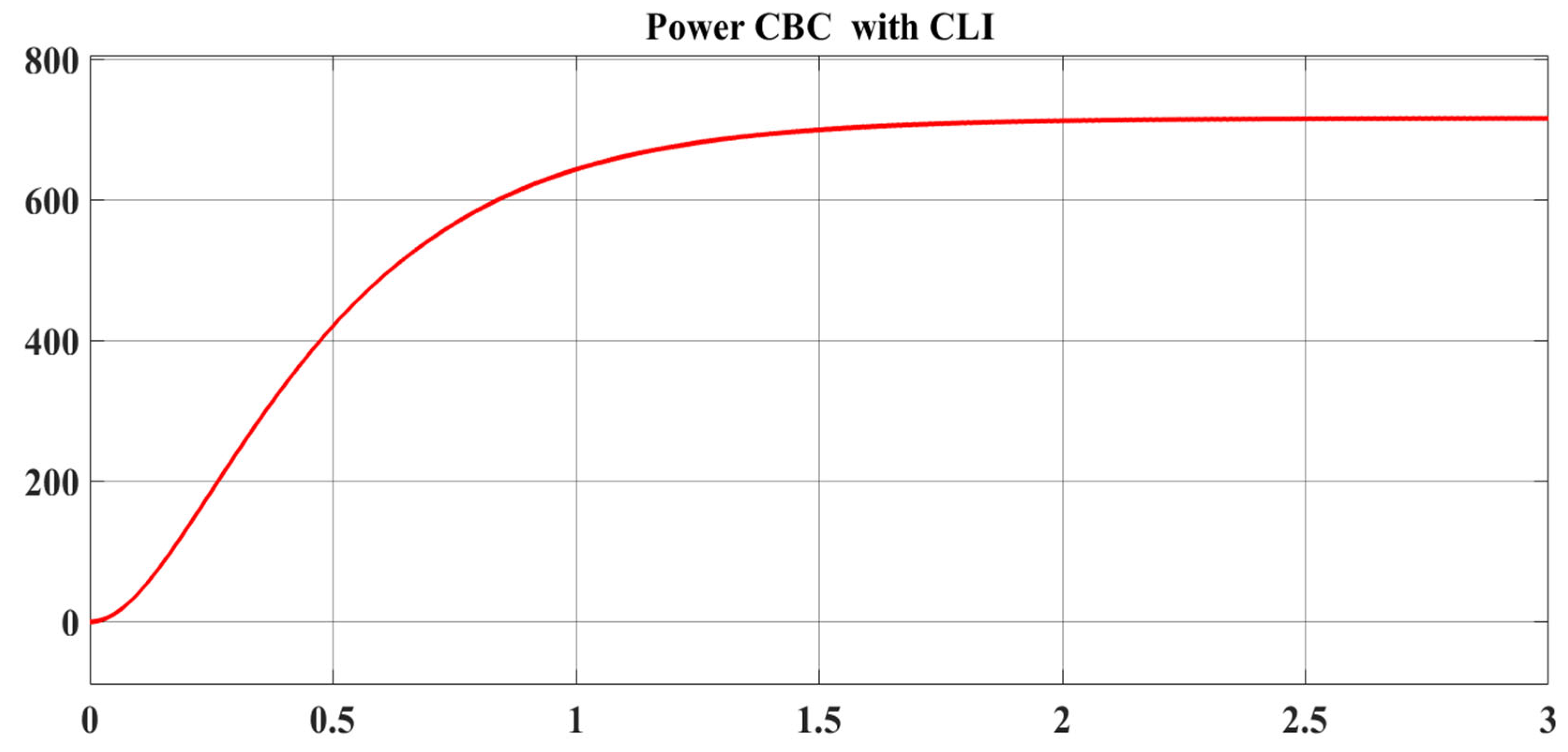
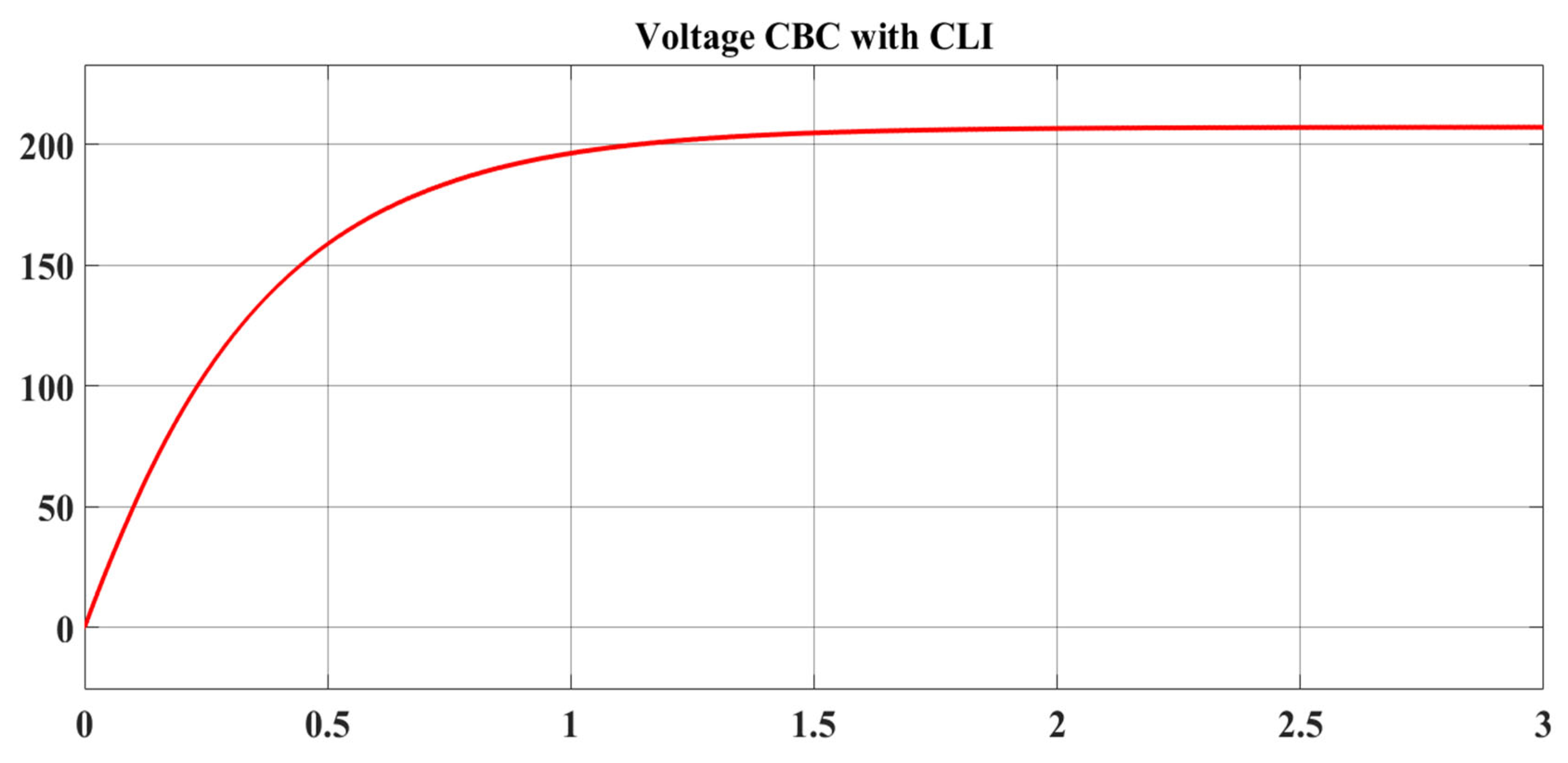
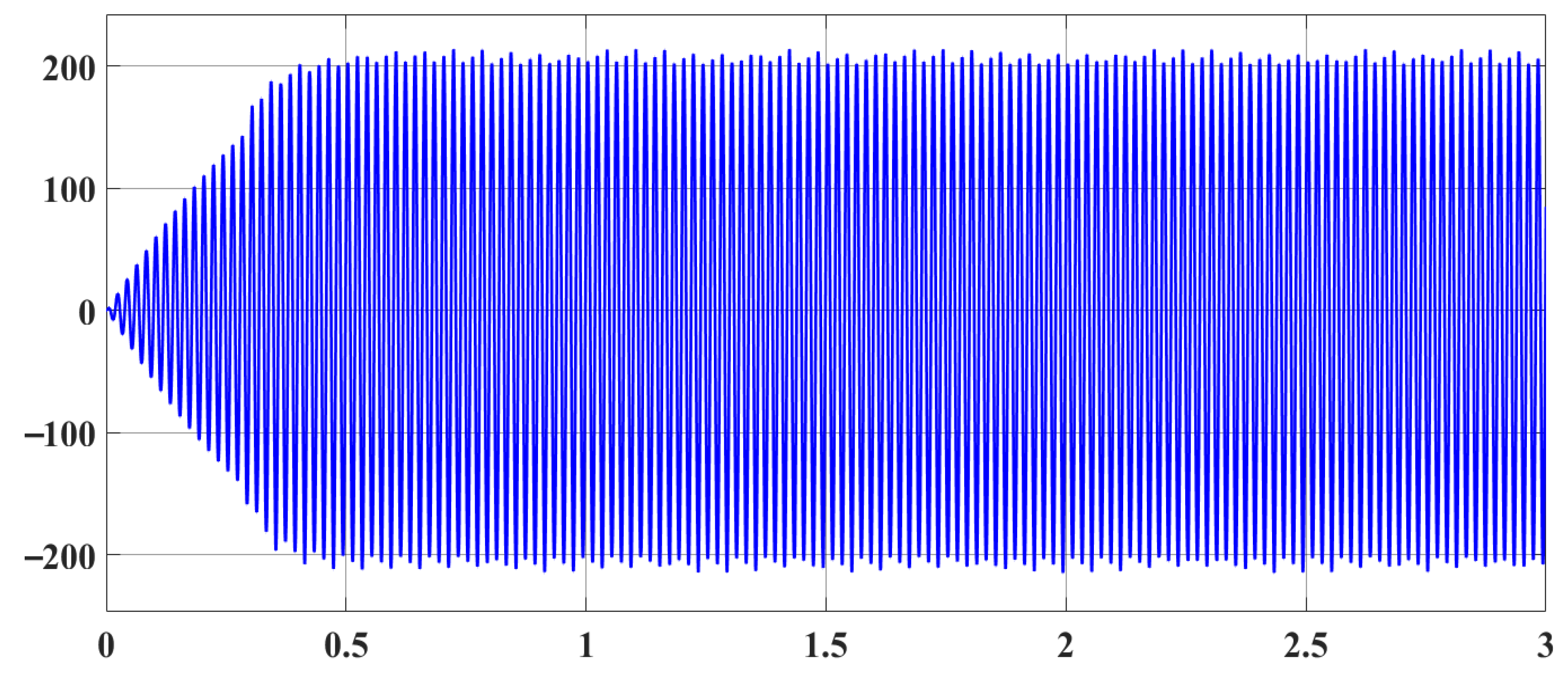

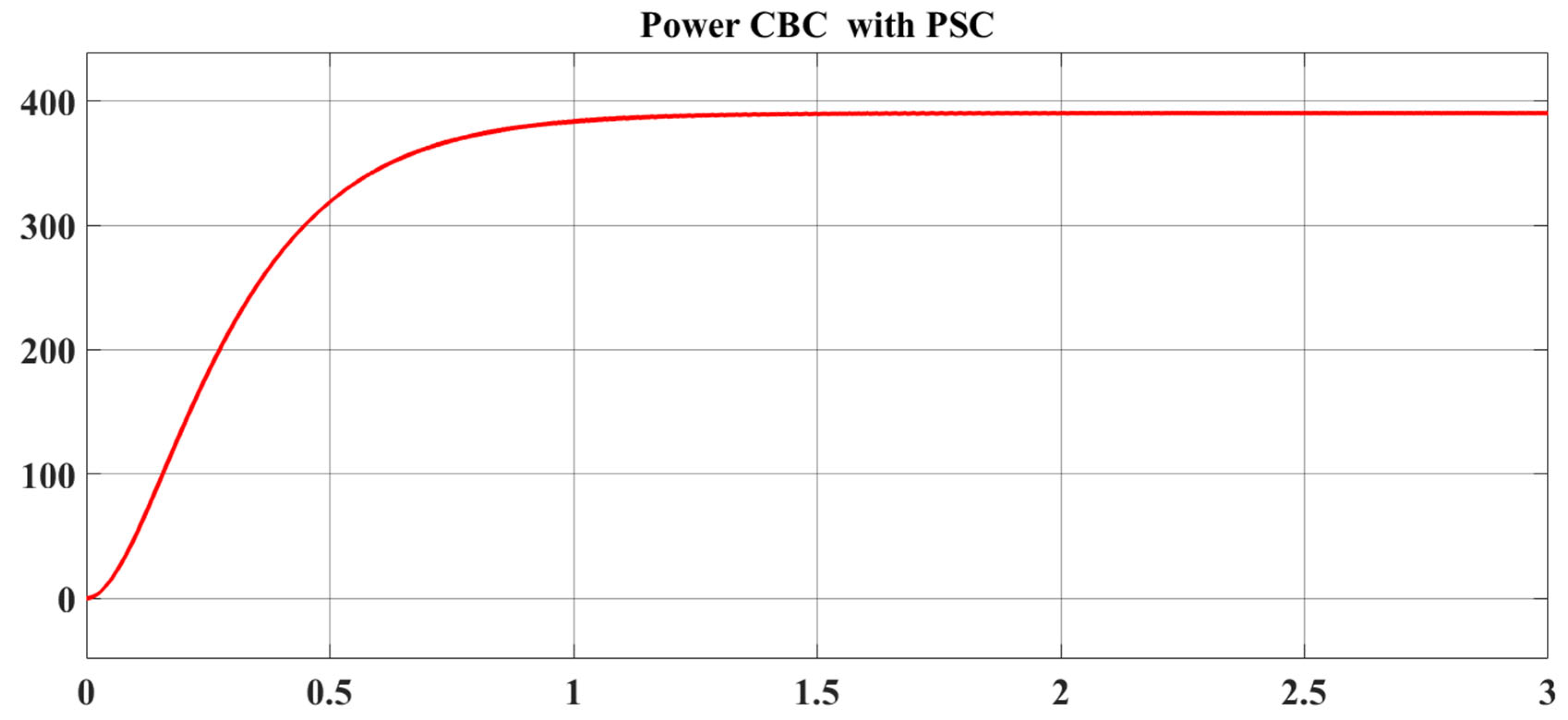
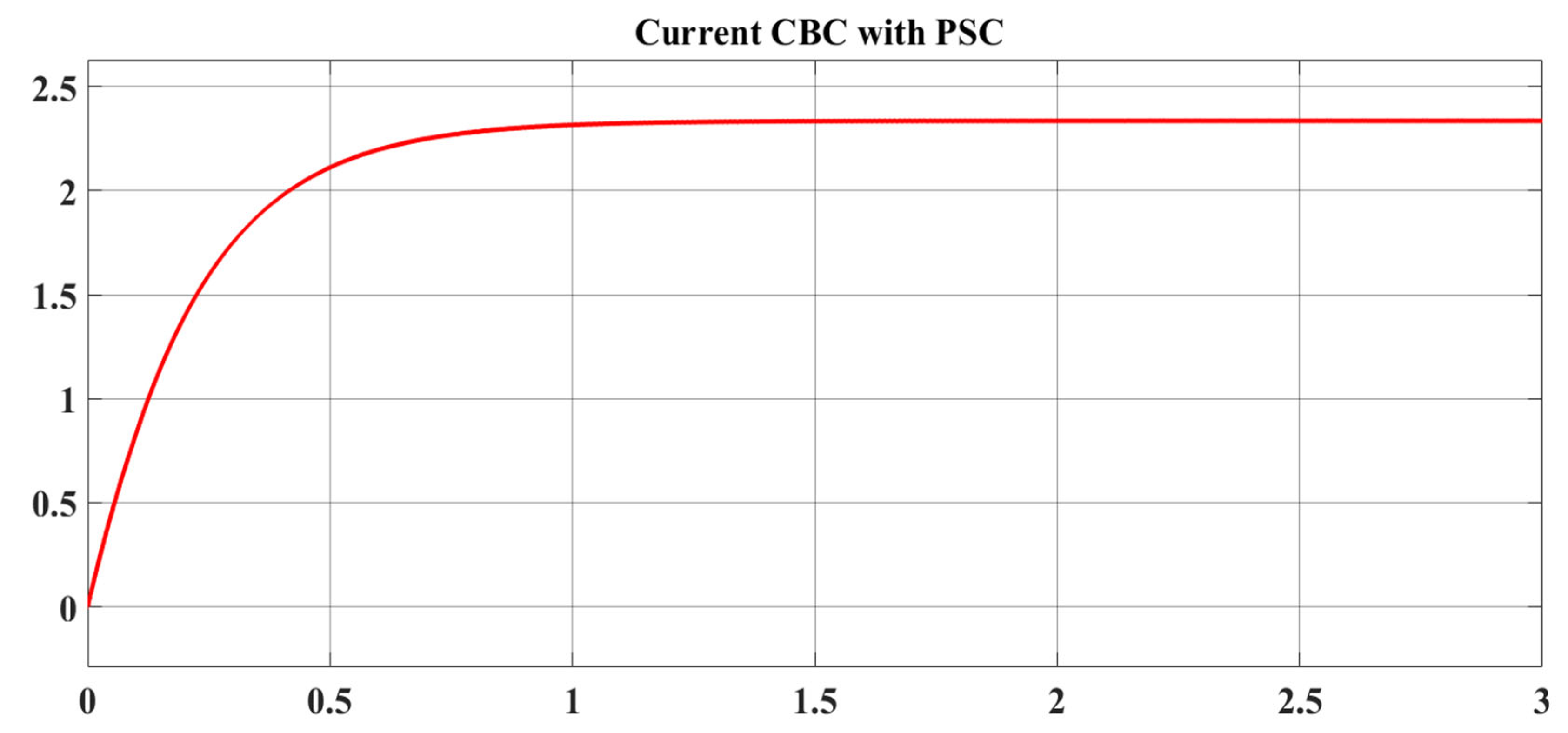

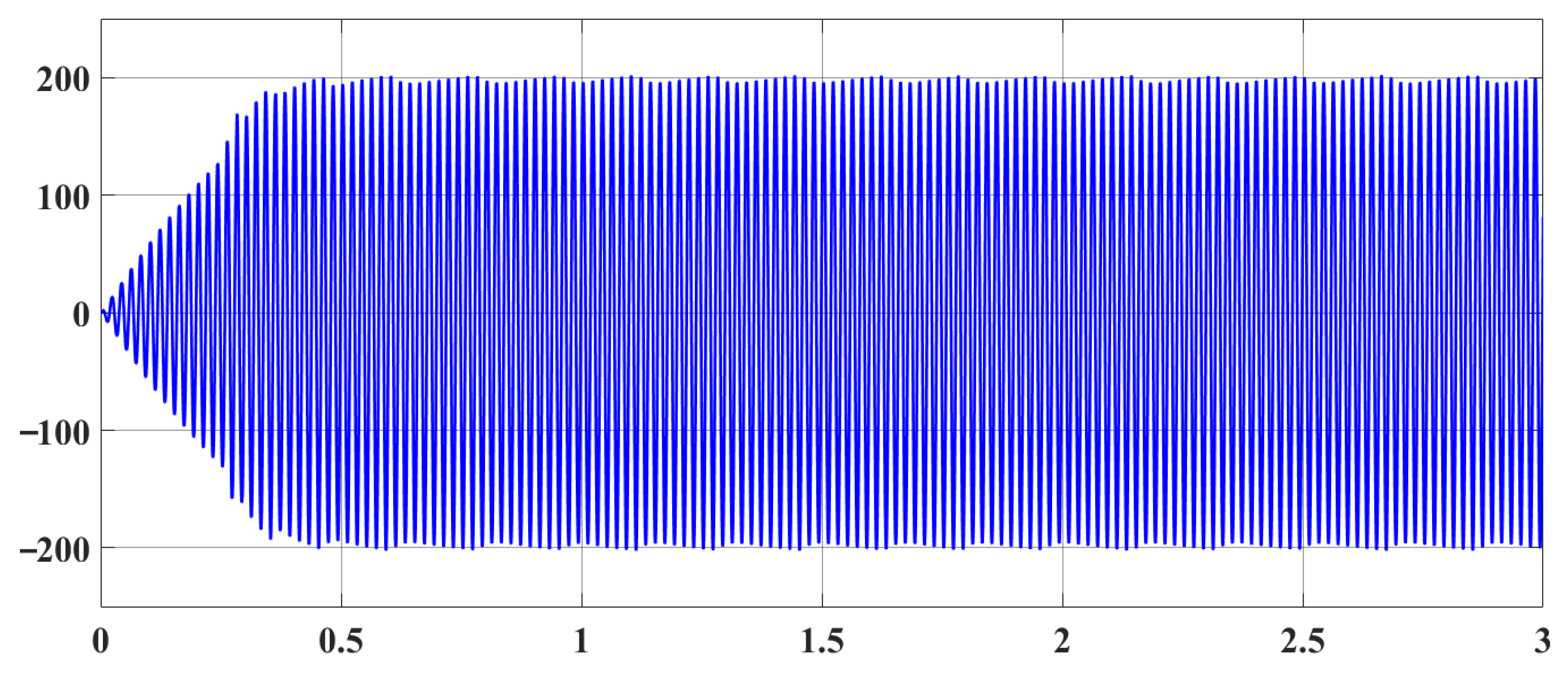
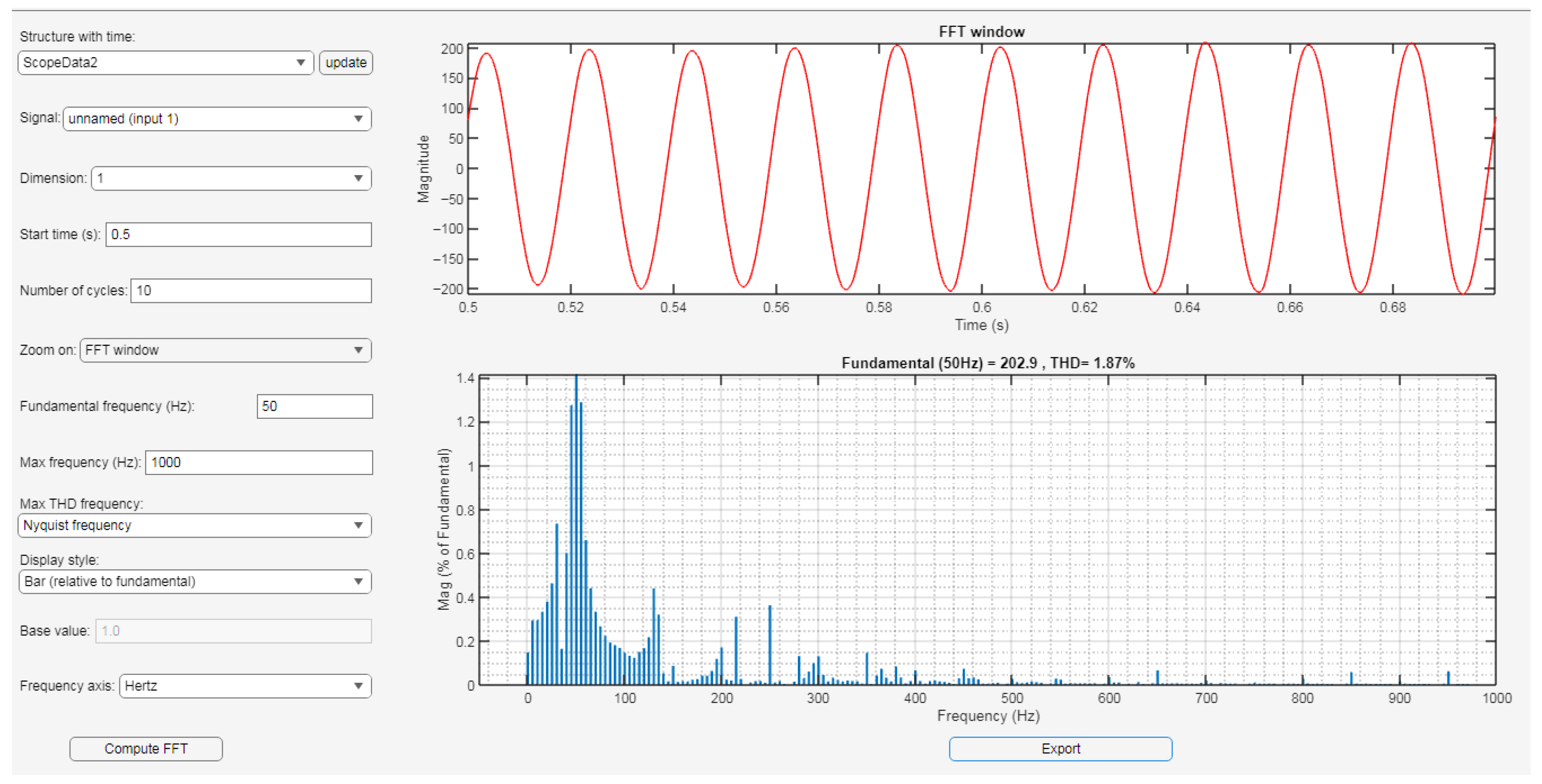
| Parameter | Value |
|---|---|
| A10 Green technology A10J-S72-175 panel | 1 Series × 1 Parallel |
| Maximum Power | 175.09 W |
| Open circuit voltage Voc | 43.99 V |
| Short-circuit current Isc | 5.71 A |
| Voltage at maximum power point Vmp | 36.63 V |
| Current at maximum power point Imp | 4.78A |
| Inductor L | 0.1 mH |
| Output capacitance | 12,000 μF |
| Duty ratio | 0.4 |
| Input voltage converter each PV | 38 V |
| Vin total input voltage boost converter | 152 V |
| Vout output voltage boost converter | 250 V |
| Error (E)/dE | NB | NS | Z | PS | PB |
|---|---|---|---|---|---|
| NB (Negative Big) | NB | NB | NB | NS | Z |
| NS (Negative Small) | NB | NB | NS | Z | PS |
| Z (Zero) | NB | NS | Z | PS | PB |
| PS (Positive Small) | NS | Z | PS | PB | PB |
| PB (Positive Big) | Z | PS | PB | PB | PB |
| Converter | CLI | PSC | ||||||||
|---|---|---|---|---|---|---|---|---|---|---|
| Output Current DC | Output Voltage DC | Output Power DC | THD Voltage AC | Efficiency | Output Current DC | Output Voltage DC | Output Power DC | THD Voltage AC | Efficiency | |
| IBC | 2.96 | 250 | 738 | 0.76% | 99.72% | 2.3 | 200 | 450 | 0.93% | 97.82% |
| CBC | 3.4 | 220 | 700 | 1.35% | 93.58% | 2.2 | 160 | 380 | 1.87% | 92.63% |
| Reference | Output Power | Input Voltage | Output Voltage | MPPT Technique | THD | Efficiency | Converter Type | Applications |
|---|---|---|---|---|---|---|---|---|
| Hassan M. H. [6] | 150 KW | 120 | 220 V | PSO P&O | - | - | Interleaved Boost Converter (IBC) | Grid-Connected PV |
| Girish Ganesan [49] | 100 W | 280 | 174 | - | - | 92% | Hybrid IBC | Renewable Energy Applications |
| Ersan Kabalci [50] | 3 kW | 200 | 250 | Kalman Filter (EKF) | - | Nor:99% PSC:96% | IBC | Under PSC |
| Sen-Tung Wu [51] | 1.5 kW | 20–125 V | 400 V | - | - | 93.57% | Interleaved Boost Serial Resonant Converter | Fuel Cell Battery |
| Shin-Ju Chen [28] | 1 kW | 36 V | 400 V | - | - | 95.69% | IBC | Renewable Energy Applications |
| K. Krishnaram [52] | 2 kW | 150 | 416 V | ANN- P&O | - | 99.80% | IBC | PV system |
| Hasan Uzmus [53] | 400 W | 135 V | 400 V | modified P&O | - | 95% | Hybrid IBC | PV System |
| Farhan Mumtaz [54] | 1.26 kW | 20 V | 400 V | P&O | 3.22% | IBC | Fuel Cell Power in a Microgrid | |
| Radhia G [55] | 642 W | - | 140 V | ANN-DISM | 99.84% | IBC | Under Partial Shading | |
| Avinash M [56] | - | 25 V | 50 V | FO-PID controller | - | - | IBC | Fuel Cell-Based Electric Cars |
| Fahrul Indra [57] | - | 50 V | 55 V | - | 3.3% | - | IBC | Renewable Energy |
| Proposal IBC for normal | 735 W | 152 V | 250 V | Fuzzy logic MPPT | 0.76% | 99.72% | IBC | Under Normal PV Conditions |
| Proposal IBC for PSC | 450 W | 152 V | 220 V | Fuzzy logic MPPT | 0.93% | 97.82% | IBC | Under Partial Shading PV Conditions |
Disclaimer/Publisher’s Note: The statements, opinions and data contained in all publications are solely those of the individual author(s) and contributor(s) and not of MDPI and/or the editor(s). MDPI and/or the editor(s) disclaim responsibility for any injury to people or property resulting from any ideas, methods, instructions or products referred to in the content. |
© 2025 by the authors. Licensee MDPI, Basel, Switzerland. This article is an open access article distributed under the terms and conditions of the Creative Commons Attribution (CC BY) license (https://creativecommons.org/licenses/by/4.0/).
Share and Cite
Al-Samawi, A.A.; Atiyah, A.S.; Al-Jrew, A.H. Power Optimization of Partially Shaded PV System Using Interleaved Boost Converter-Based Fuzzy Logic Method. Eng 2025, 6, 201. https://doi.org/10.3390/eng6080201
Al-Samawi AA, Atiyah AS, Al-Jrew AH. Power Optimization of Partially Shaded PV System Using Interleaved Boost Converter-Based Fuzzy Logic Method. Eng. 2025; 6(8):201. https://doi.org/10.3390/eng6080201
Chicago/Turabian StyleAl-Samawi, Ali Abedaljabar, Abbas Swayeh Atiyah, and Aws H. Al-Jrew. 2025. "Power Optimization of Partially Shaded PV System Using Interleaved Boost Converter-Based Fuzzy Logic Method" Eng 6, no. 8: 201. https://doi.org/10.3390/eng6080201
APA StyleAl-Samawi, A. A., Atiyah, A. S., & Al-Jrew, A. H. (2025). Power Optimization of Partially Shaded PV System Using Interleaved Boost Converter-Based Fuzzy Logic Method. Eng, 6(8), 201. https://doi.org/10.3390/eng6080201








